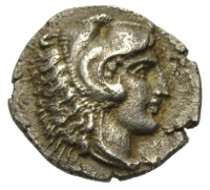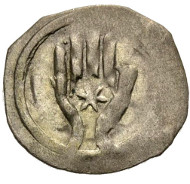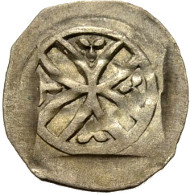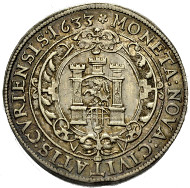10-12-2014 – 01-01-1970
41st Auction
Myths, Monsters and More …
The sale opens with a range of ancient coins from Italy and Sicily. Many of these bear witness to the wide range of Gods and demigods worshipped here in ancient times; particularly unusual is the depiction of the youthful head of Amphitrite (or Thetis) on a bronze coin of the Bretti (No. 7), who as a Nereid or sea Nymph wears a headdress in the form of an inverted crab, a feature which cannot be entirely explained from literary sources! Another image firmly associated with the land which produced it is found on a coin of Sicily struck in Syracuse under Timoleon in ca. 317 B.C. (No. 21): the Triskelis, a group of three bare legs depicted together to form a symbol with rotational symmetry. The ancient inhabitants of Sicily adopted this motif from very early times to reflect the triangular form of their island, which was also known as „Trinakria“, „the three-cornered island“ (Strabo 6.2.1). Other Sicilian highlights include a Tetradrachmon from Leontinoi with the city’s symbol, a lion’s head surrounded by four barleycorns (No. 14), a litra coin from the same town featuring the head of Apollo (No. 15), and the rare bronze of Agathokles with a sitting dog on the reverse (No. 23). The Lipari Islands, a group of seven large and five small islands north of Sicily, are also represented here: a bronze Onkia depicts the bearded head of the smith-god Hephaistos / Vulcan, while on a smaller Tetras the same god is depicted seated with a hammer and a cup (Nos. 28 and 29).
Other Classical highlights include the Tetrobol with facing head of Hermes from Ainos; frontal representations of this kind are particularly prone to damage, but ours has survived the centuries with his nose intact (No. 31). The mythological theme continues with an extremely fine portrait of a bearded Silenos from Pantikapaion (No. 39) and a Gorgon drachm from Neapolis in Macedonia with outstretched tongue, an image believed by the ancients to ward off evil (No. 44).
No. 72: ARCADIA, STYMPHALOS. Obol, 350-340 B.C. BCD, Peloponnesos I,1697. SNG Cop. 285. J. Warren, The 1980 Kato Klitoria Hoard, Essays Kraay-Morkholm 295,80. Very rare. Av. Extremely fine. Rv. Very fine. Estimate: 750.- euro.
Another rarity with a legendary story attached to it is the Obol from Stymphalos in Arcadia featuring the head of Herakles on one side and the head and neck of a Stymphalean bird, a reference to Herakles‘ slaughter of these particularly dangerous creatures which formed one of his twelve labours, on the other (No. 72). Io, the daughter of Inachos with whom Zeus had one of his many affairs, is depicted on the elektron Hekte from Phokaia in Ionia (No. 85); that she was subsequently transformed into a heifer is subtly indicated by the cow-horn on the side of her head. The Seleucid kings of Syria also used images of the gods to good effect on their coins, such as that of Apollo seated on the Omphalos on the Tetradrachmon of Antiochus I. of Syria (No. 97). Mythological images were widely used throughout the ancient world to indicate the religious affiliations and legendary ancestors of the ruling clases. The Ptolemys of Egypt were no exception, but they also looked back to the founding members of their dynasty and depicted them on their coinage, such as on the gold ½ Mnaion minted by Ptolemy II. on which he depicts not only himself and his queen Arsinoe II., but also Ptolemy I. and Berenike (No. 116). The North African city of Cyrene featured not only the gods Zeus Ammon and Apollo Karnaios on their coins, but also a famous export product of theirs, the plant Silphion, which had numerous culinary and medicinal uses (Nos. 129-130), and even more unusually, produced a coin type depicting a crab and a Jerboa, a desert-living rodent (No. 132).
The Greek cities under the Roman Empire often adorned their coinage with local gods and animals. The river-god Hermos is twinned with a scorpion on the coin of Magnesia on the Sipylos in Lydia (No. 139), while on the coin of Antoninus Pius from Lykaonian Savatra the local river-god is depicted with a fish (No. 140). Another (sea-)fish occurs on the coin of Gades in Spain (No. 143) alongside the head of Herakles.
The Greek section of the sale is followed by a small selection of Celtic coins, including a gold Stater of the Veliocasses with an extremely well preserved stylized horse on the reverse (No. 147). Roman coins on offer include a Denarius with a youthful portrait of Marcus Aurelius (No. 153) and a Sestertius of Lucius Verus minted in 161-162 (No. 155). The series continues with a number of fine coins minted under Diocletian, including a Nummus stuck in London (No. 163); there is also a rare bust-type of Maximinianus portrayed as Hercules with a club and lion-skin from Lyon (No. 167). The ancient section of the sale closes with a series of late Roman and Byzantine gold and silver coins, and the start of the Medieval period follows with a series of Frankish-Alemannic Half Siliquae modelled on their late Roman predecessors (Nos. 198-203).
No. 233: ISNY. Heller. Nau 2. Very fine – extremely fine. Estimate: 100.- euro.
There is a series of Hellers from Schwäbisch Hall featuring a hand; other towns in Southern Germany copied the coin type and produced similar looking coins with different letters and symbols within the hand-motif, such as the letter D for Dillingen (No. 225 ff.), N for Nuremberg (No. 236-237) or a star for Isny (No. 233).
A particular historical highlight is the medal commemorating the life and death of Joseph Süskind Oppenheimer, known as „Jud Süs“, who acted as financial advisor to Duke Karl Alexander of Württemberg and was later seized and put to death on the gallows after the death of the Duke (No. 255). There follows a series of silver 2, 3 and 5 Mark coins issued during the German Reich 1871-1918; this collection is remarkable for the perfect condition of the coins. There is a high percentage of Proof coins, perfect unimpaired Proofs.
No. 630: SWITZERLAND, CHUR. Taler 1633. Trachsel 527. HMZ 2-485e. Extremely fine. Estimate: 2500.- euro.
Italian medieval coins are offered as well as Swiss coins and medals.
The sale closes with a selection of antiquarian numismatic literature. There is a copy of L. W. Hoffmann’s Alter und Neuer Münz-Schlüssel from 1715 bound in contemporary half-leather with many engraved plates of coin illustrations, as well as books about ancient and medieval numismatics, including numerous titles of Swiss interest, and a wide range of 19th and 20th century European auction catalogues, many extremely rare.
The catalogue can be viewed online here. Printed copies are available for the price of 10,- from Münzen & Medaillen GmbH, Hauptstrasse 175a, D-79576 Weil am Rhein, Germany.










